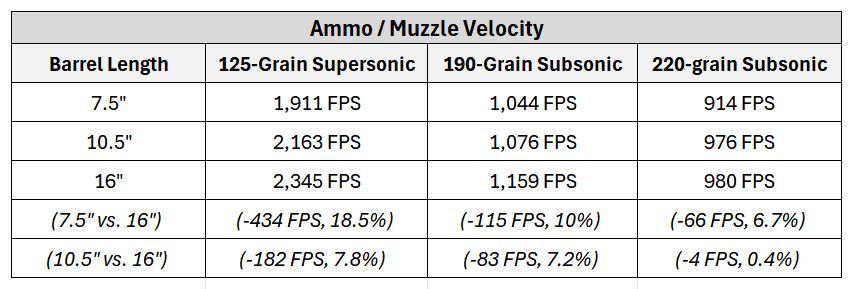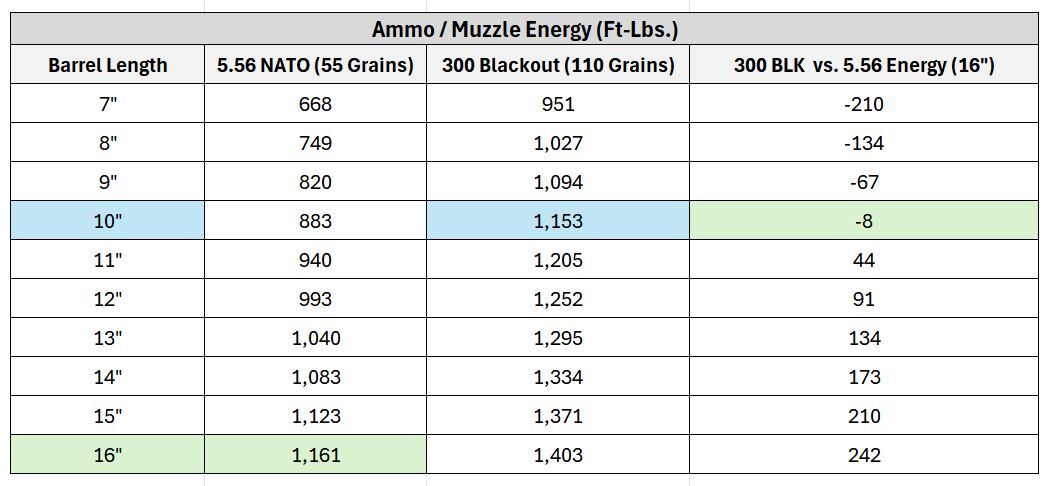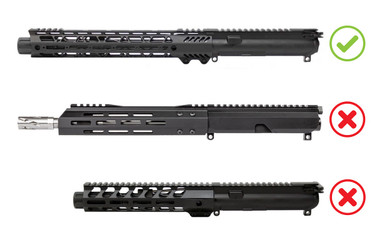The Best 300 Blackout Barrel Length (With Ballistics Data)
Posted by Gunbuilders.com on Jun 25th 2025
The best overall barrel length for .300 Blackout is 10.5". There you go! You can leave now. But you probably want to know why this is the optimal barrel length, especially if you're building your next AR-15. We've got the ballistic data comparing 300 Blackout barrel lengths and velocities to illustrate why 10.5" is optimal. There are plenty of other reasons (which are seldom discussed) for why this is the best barrel length.
Let's cover it all.
Why 10.5" Is The Best .300 BLK Barrel Length
There are four reasons why this is the ideal barrel length. To come to this conclusion, this writer built nearly a dozen uppers and conducted endless testing with fixed and adjustable gas blocks, chambered supersonic and subsonic loads, and shot hundreds of rounds suppressed and un-suppressed.
This Length Achieves Optimal Velocity & Power
The 10.5" barrel produces optimal velocities for both supersonic and subsonic loads. "Optimal" means that increasing barrel length any further will not produce a significant increase in muzzle velocity.
Put another way, "optimal" also means that the cartridge in question loses less than 10% of its nominal or advertised muzzle velocity. For 300 Blackout, most ammo manufacturers measure nominal velocity using 16" barrels. So, the 16" barrel length will be the standard against which we compare ballistic data for other barrel lengths.
The ballistic charts below illustrate these comparisons. But velocity isn't the only factor to consider; there are other reasons why 10.5" is ideal.
An Adjustable Gas Block is Not Required At This Length
The 300 Blackout round gets finicky when you swap out supersonic rounds for subsonics. A gun that might be appropriately gassed for cycling supers may wind up short-stroking or failing to cycle with subs, because less gas is produced.
But with a 10.5" barrel, the subsonic round's dwell time is sufficient to cycle the bolt without the need for an adjustable gas block. At this barrel length, supersonic rounds don't produce too much felt recoil with a fixed block, the gun is neither over- nor under-gassed, and you'll enjoy reliable cycling with either load.
This Length Maximizes Powder Burn, Reducing Fouling
Ever come back from the range after firing a bunch of subsonic loads, only to find your upper and lower receivers are caked with little yellow and gray pellets? That's unburnt powder. This is a common but often overlooked "quirk" of 300 Blackout. Shorter barrels -- roughly 7.5" to 9.5", from this writer's testing -- simply can't produce the full powder burn necessary to eliminate this fouling.
But with a 10.5" barrel, the amount of unburnt powder you'll experience is minimal, if not nonexistent. This barrel length noticeably reduces carbon fouling, making cleaning and maintaining your gun easier. Again, this writer speaks from personal experience.
This Length Produces identical muzzle energy vs. 5.56 NATO
U.S. special operations forces began fielding short-barreled rifles chambered in 5.56 NATO for urban combat, and they noticed these guns produced sub-optimal takedown power and performance. 300 Blackout was developed to remedy this issue.
Its goal was to fit in a short-barreled rifle while still providing roughly the same power of 5.56 NATO when that round's chambered in a standard-length rifle.
Which barrel length offers this comparable amount of power? You guessed it: 10.5", and we'll prove it with ballistic data.
Why 10.5" is Ideal: The Ballistic Data
Onto the most important reason why this barrel length is best. Compared to the velocities produced with a 16" barrel, the 10.5" barrel offers optimal performance. You'll also find that going shorter than 10.5" yields comapratively bigger drops in velocity.
300 BLK Barrel Length vs. Velocity Chart

Data courtesy of Sniper's Hide (recorded using Garmin Xero C1 chronograph)
This chart compares supersonic (125-grain) and subsonic (190- and 220-grain) 300 Blackout velocities in various barrel lengths: 7.5", 10.5", and 16".
Appyling the rule for what we consider to be optimal muzzle velocity, we can see that the 10.5" barrel neatly meets the definition: The supersonic load only loses 7.8% of its nominal velocity. Even more impressive is that the heaviest subsonic load remains truly optimized in a 10.5" barrel. It loses just 0.4% of its nominal velocity.
The shorter barrel (7.5") does not meet this definition. We see the supersonic load loses nearly 20% of its muzzle velocity, while the 190-grain subsonic load loses 10%. Only does the heaviest subsonic (220-grain) approach nominal velocity, losing around 6.7%.
300 BLK Barrel Length vs. Energy Chart
300 Blackout was specifically designed to be chambered in a shorter barrel, while offering muzzle energy comparable to 5.56 NATO when that round is fired from a 16"-barreled rifle. So, at what barrel length does 300 BLK satisfy this requirement?

Once again, we find 10.5" prevails. When chambering supersonic (110-grain) loads, 300 BLK produces more than 1,153 ft-lbs. of energy at this barrel length, and 5.56 NATO's M193 (55-grain) load produces 1,161 ft.-lbs of energy in a 16" barrel.
Go any shorter, and 5.56 winds up producing more muzzle energy.
Recap: Why 10.5" is Best
We covered a lot of data, so here's a quick recap. the 10.5" barrel length is best for 300 Blackout because it:
- Produces optimal performance, losing less than 10% of nominal velocities for supersonic and subsonic loads.
- Ensures subsonic loads have enough dwell time to cycle the bolt, without the need for an adjustable gas block.
- Virtually eliminates unburnt powder from subsonic rounds being deposited in the upper and lower receivers.
- Produces as much muzzle energy as a 16"-barreled 5.56 NATO gun, as it was specifically intended to do.
Can you go with a shorter barrel? Yes, but you will:
- Lose more than 10% of nominal velocity for some supersonic loads.
- Potentially need an adjustable gas block to cycle both subs and supers.
- Experience some unburnt powder deposits in your receivers and bolt.
- Produce less muzzle energy than a 16"-barreled 5.56 NATO gun.
(Want to Out-Perform 5.56/.223 with 300 BLK?)
If you couldn't tell, we love the 300 Blackout cartridge. When it's chambered in a standard rifle, it offers surprising advantages over 5.56 NATO. Read our next guide to see why 300 Blackout might be the better overall choice.
DISCLAIMER: If you are new to the world of DIY gun building, you likely have a lot of questions and rightfully so. It’s an area that has a lot of questions that, without the correct answers, could have some serious implications. At GunBuilders.com, we are by no means providing this content on our website to serve as legal advice or legal counsel. We encourage each and every builder to perform their own research around their respective State laws as well as educating themselves on the Federal laws. When performing your own research, please be sure that you are getting your information from a reliable source.

